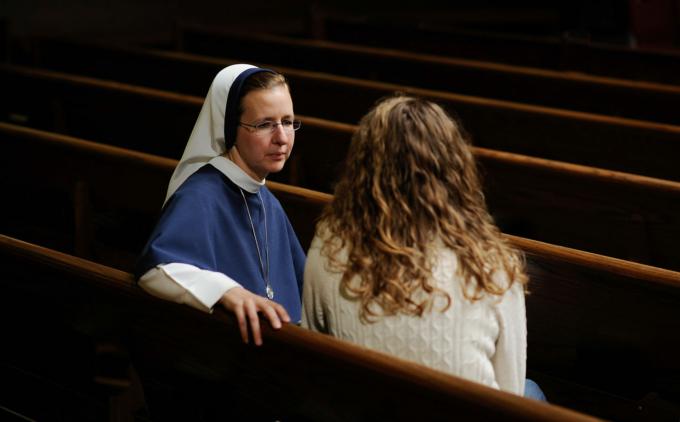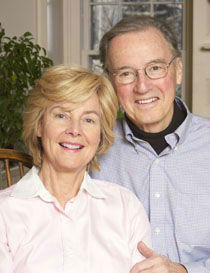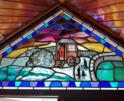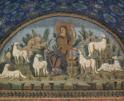
Faith
It appeared as if the unselfish, heroic work of generations of sisters in America was in a death spiral. Not so!

Ryan
Other than the revolutionary "Good News" of the Gospels, there is not a great deal of good news about the Catholic Church. The Roman Catholic Church in the United States has lost one-third of its members in recent years. The figure for New England is even greater -- 50 percent of Catholic high schoolers claim to have joined the ranks of the "nones." The secular media continues to gleefully seize on every "priest abuse," even though the offenders are typically long gone. Nevertheless, there is interesting and, frankly, exciting news about the growth of vocations among religious sisters.
Last month the Huffington Post, hardly a friend of organized religion, printed a long article entitled "Behold, the Millennial Nuns." The piece, authored by a non-Catholic woman, attempts to explain why, after 50 straight years of decline, more and more young women are choosing to enter religious life. The author reported the 2010 data on the apparent demise of the religious orders of women. For instance, that 50 years ago there were 180,000 Catholic sisters and the number had been reduced to 50,000. And, that the same year, more religious sisters were over the age of 90 than there were under 60.
But that tide has dramatically reversed itself. In a 2017 Georgetown University poll of American Catholic women aged 18 to 35, 13 percent of the women reported interest in becoming religious sisters. The apparently shocked author commented, "That's more than 900,000 young women, enough to repopulate the corps of women religious in a couple of decades, even if only a fraction of them actually go through with it." Amid this horrible cultural decline, the insanity over gender, the hatred of the virtue of obedience, God works in the world, restoring his Church. Perhaps we need to replace that snarky bumper sticker "S*** Happens" with "Grace Happens!"
Apparently millennial women who have actually entered religious life are different from those of the past who typically entered after high school. Today they enter at an older age, with the bulk entering between 24 and 40; and are bettered educated with 70 percent holding college degrees, 19 percent with master's degrees and 5 percent with doctorates. Interestingly, 14 percent of them report having been homeschooled. And they reflect the current racial profile of the country with 17 percent Latina, 16 percent Asian/Pacific Islanders and 8 percent black. Many have had impressive executive experience in business or scholarly careers in academia.
The attraction to the discipline and rigors of religious life is confusing to many observers. Why would modern women -- women who have lived successful and independent lives -- be drawn to such a truly counter-cultural life. Fifty-nine percent report they have entered because of "a desire to serve." The more complete answer, of course, is buried in their hearts and minds and their personal history, or, by what was once claimed, "She has a vocation."
Three or four years ago, cultural guru Oprah Winfred did a series of TV shows on an order of nuns in Ann Arbor, Michigan, which is still available on YouTube. The average age of the 113 sisters was 28; and the show explored these women at prayers, at work and at play. Oprah, like so many of the viewers, was visibly surprised by the sheer joy and exuberance of these cloistered women who had freely taken vows of poverty, chastity, and obedience. The sisters were clear and direct about what they had left behind and the life they had embraced. What emerged from the shows was a picture of a way of life of deep spiritual fulfillment, rich in friendships and profound meaning. Following the airing, the applications to that convent more than doubled.
Oprah's "expose" is just the tip of a media iceberg. Men and women considering religious vocations have a huge presence on the Internet with a number of resources to explore their options. One source is Vision Vocations, offering an opportunity to narrow their search through "Vocation Match." In addition, for women discerning their future, there are several lively blogs, such as Sister Helena Burns' outspoken "Hell Burns" (hellburns.blogspot.com) and Lifetimes' popular reality TV show, "The Sisterhood: Becoming Nuns." These resources are light on pious sentiment and strong on the pluses and minuses of today's religious life.
The appeal of sisterhood is hardly new. At its heart is a call to a more spiritually fulfilling life, a life of greater significance than the secular world offers. Theirs is hardly a retreat from the modern world, but a response to the world's crying needs. While many will follow traditional roles as teachers and nurses, many will run shelters for pregnant or abandoned women, homes for abused children or a myriad of critical needs.
While the writings of many millennial sisters frankly acknowledge their sacrifices of married life and of raising children, they see their embrace of chastity as a positive good. On the other hand, who can blame them for rejecting the current poisoned dating-and-mating environment. What millennial woman is not familiar with the bar-centered, hook-up culture inhabited by baby-men, perpetual boys whose taste for women has been distorted by their porn habits.
It appeared as if the unselfish, heroic work of generations of sisters in America was in a death spiral. Not so! These women planted seeds and a new crop is coming to harvest. All Catholics should take heart and support these dedicated millennials. The rediscovery of the religious life and, particularly the revitalization of the Catholic sisterhood could not come at a better time!
- Kevin and Marilyn Ryan, editors of "Why I'm Still a Catholic," worship at St. Lawrence Church in Brookline, Mass.
Recent articles in the Faith & Family section
-
Popular devotions and the liturgyFather Robert M. O’Grady
-
The Fight for Our FaithMaureen Crowley Heil
-
The shepherd's voiceScott Hahn
-
Scripture Reflection for April 21, 2024, Fourth Sunday of EasterJem Sullivan
-
The new Temple: How Easter changes religionDr. R. Jared Staudt


















